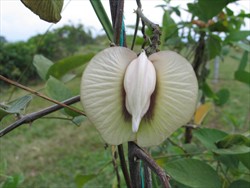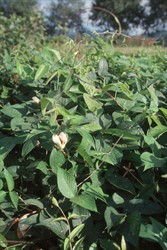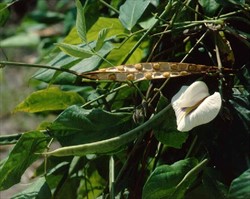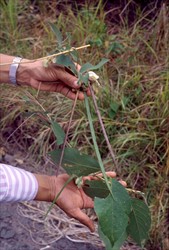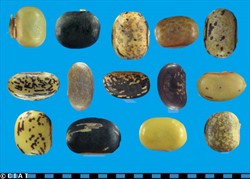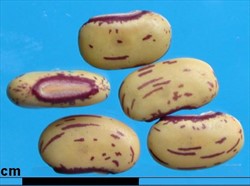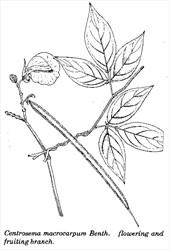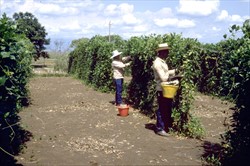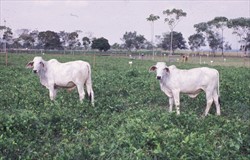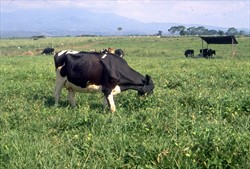Centrosema macrocarpum
Tropical Forages
Centrosema macrocarpum Benth.
Subordinate taxa:
Centrosema macrocarpum Benth. var. macrocarpum
Centrosema macrocarpum Benth. var. andinum Schultze-Kraft & Belalc.
GRIN: Centrosema seymourianum Fantz
ILDIS: Bradburya macrocarpa (Benth.) Kuntze; Centrosema lisboae Ducke; Centrosema magnificum Malme
Family: Fabaceae (alt. Leguminosae) subfamily: Faboideae tribe: Phaseoleae subtribe: Clitoriinae.
Tap-rooted, trailing and twining perennial herb with slender stems, rooting at the nodes in some genotypes. Stems pilose with greyish hairs when young, glabrescent, lignified at base. Leaves trifoliolate; stipules triangular, petioles and petiolules pubescent; leaflets broadly to narrowly ovate, acute to acuminate at the apex, rounded or slightly wedge-shaped at the base; central leaflet larger and with longer petioles than the laterals, mostly 8‒13 cm long, 3‒8 cm wide, papyraceous to subcoriaceous, almost glabrous to pubescent on lower or both surfaces; frequently with a light-green marking along midrib. Inflorescence an axillary raceme with up to 30 flowers inserted in pairs along rachis; flowers papilionate, subtended by a pair of ovate-lanceolate-falcate bracteoles; calyx campanulate, 5-teethed with carinal tooth considerably longer than others; petals showy and cream-coloured with purple centre; standard orbicular-emarginate, 3‒6 cm in diameter, pubescent outside; wings and keel much smaller than standard, directed upwards. Pod linear, compressed, up to 30 cm long, 1 cm wide, straight to slightly bent and beaked, subglabrous, containing up to 25 seeds, dehiscent. Seeds transversely oblong to rectangular, on average 5 mm × 3 mm, yellowish-brownish or black, plain, mottled or marbled. 15,000‒25,000 seeds/kg.
var. macrocarpum: young shoots mostly green; corolla 3–3.5 cm long, white fading dull yellowish, maroon medially and along veins; pod 100–190 mm long, 6–8 mm wide, beak 12–18 mm long; seeds 5 mm × 3 mm, yellowish-brownish or black, plain, mottled or marbled.
var. andinum: young shoots reddish in colour; corolla 3–4 cm long, purple-violet with yellow-greenish vertex; pod 160–355 mm long, beak 17–40 mm long; seeds 9–11 mm long, 5–6 mm wide, yellow with irregular purple lines.
None reported
var. macrocarpum
Native:
Northern America: Mexico (Chiapas, Guerrero, Jalisco, Nayarit, Oaxaca, Puebla, Quintana Roo, Tabasco, Veracruz)
Caribbean: T rinidad and Tobago
Central America: Belize, Costa Rica, El Salvador, Guatemala, Honduras, Nicaragua, Panama
South America: Bolivia, Brazil (Bahia, Federal District, Goiás, Maranhão, Mato Grosso, Mato Grosso do Sul, Pernambuco, Piauí, Roraima); Colombia; Ecuador (Los Rios, Napo); Guyana, Peru (San Martin); Venezuela
var. andinum
Native:
South America: Colombia (Antioquia, Caldas, Magdalena, Risaralda, Valle del Cauca)
Forage
Grazed pastures in mixture with grasses, as legume-only protein banks, cut-and-carry.
Environment
Soil cover in orchards and plantations.
Soil requirements
Adapted to low- to medium-fertility, well drained soils of various textures, particularly loams. Tolerates very acid conditions, with high soluble Al and Mn.
Moisture
Humid to sub-humid climate with annual rainfall >1,000 mm, 3‒6 dry months. Once established, is very drought tolerant.
Temperature
Occurs naturally from 22º N in Mexico to 18º S in Bolivia, and from near sea level over much of the latitudinal range to 1,650 m asl in Colombia. Average annual temperatures at collection sites are mostly in the range 24‒26 ºC, and down to 22 ºC. Warm season growth only.
Light
Moderately shade tolerant.
Reproductive development
Very photoperiod-sensitive: flowering triggered by short days even close to the equator, and stimulated by removal of accumulated biomass. Tripping of flowers by large insects required for pod set.
Defoliation
Tolerant of grazing and cutting once well established, but in mixtures with grasses tends to decline under intensive grazing.
Fire
Well-established plants recover after fire.
Guidelines for establishment and management of sown forages.
Establishment
Seed should be inoculated with Rrhizobium strain CIAT 3101 (= CB 3125 in Australia) prior to sowing. A sowing rate of 3‒5 kg/ha of scarified seed is usually adequate.
Fertilizer
Responds well to fertilisation on low fertility soils, mainly P and K.
Compatibility (with other species)
Combines well with bunch grasses and other species that produce a more open stand.
Companion species
Grasses: Andropogon gayanus, Urochloa brizantha, U , Megathyrsus maximus.
Legumes: Stylosanthes capitata, S. guianensis.
Pests and diseases
Not seriously affected by the major Centrosema diseases, Rhizoctonia foliar blight, anthracnose, Cercospora leaf-spot and bacterial wilt. Soybean mosaic virus infection by aphids has been reported. Insects may eat leaves, especially during dry periods.
Ability to spread
Spread is localised by stolon development, extensive spread being limited by low amounts of seed produced under grazing.
Weed potential
None.
Dry matter
On low-fertility soils: <1‒5 t DM/ha/12 weeks, and up to 15 t/ha/yr.
Animal production
In association with Andropogon gayanus, 170‒200 kg LWG/steer/yr (400‒600 kg/ha/yr) possible. In association with Andropogon gayanus or Urochloa humidicola, milk yields of Holstein cows 15‒20% higher than on grass alone.
2n = 22; self-fertile, but considerable outcrossing associated with dependence on tripping by insects (bumble bees).
Handpicked seed yields of 50‒500 kg/ha have been obtained from a potential yield of 800 kg/ha.
Tolerant of alachlor, metolachlor and pendimethalin, but not oxyfluorfen, pre-emergent herbicides; and of bentazone and fluazifop-butyl, but not 2,4-D amine and dalapon as post-emergent applications.
- Adaptation to very acid, low-fertility soils.
- Good drought tolerance.
- High nutritive value.
- Tolerant of main Centrosema diseases.
- Selectively grazed.
- Lack of persistence in mixture with grasses.
- Low seed production without proper managerial skills.
Coradin, L. and Ramos, A.K.B. (2016) Centrosema macrocarpum (Centrosema). In: Vieira, R.F., Camillo, J. and Coradin, L. (eds) Espécies Nativas da Flora Brasileira de Valor Econômico Atual ou Potencial: Plantas para o Futuro ‒ Região Centro-Oeste. Secretaria de Biodiversidade, Ministério do Meio Ambiente, Brasília, DF, Brazil. p. 499‒504. https://bit.ly/2UMZUzo
Keller-Grein, G., Amézquita, M.C., Lema, G. and Franco, L.H. (1993) Multilocational testing of grasses and legumes in the humid tropics of South America. hdl.handle.net/10568/72179
Lascano, C.E. and Avila, P. (1991) Potencial de producción de leche en pastures solas y asociadas con leguminosas adaptadas a suelos ácidos. Pasturas Tropicales 13(3):2–10. bit.ly/2QIx0Oz
Pérez, J.M., Szott, L.T. and Arévalo, L.A. (1993) Pijuayo con cobertura de leguminosas. In: Mora Urpí, J., Szott, L.T., Murillo, M. and Patiño, V.M. (eds) Memorias del IV Congreso Internacional sobre Biología, Agronomía e Industrialización del Pijuayo, Iquitos, Perú, 1989. Editorial de la Universidad de Costa Rica, San José, Costa Rica. p. 309–322.
Schultze-Kraft, R. (1992) Centrosema macrocarpum Benth. In: Mannetje, L.’t and Jones, R.M. (eds) Plant Resources of South-East Asia No. 4. Forages. Pudoc Scientific Publishers, Wageningen, the Netherlands. p. 82–84. edepot.wur.nl/327785
Schultze-Kraft, R. and Belalcázar, J. (1995) Una nueva variedad de Centrosema macrocarpum Benth. (Leguminoae: Papilionoideae) de los Andes Colombianos. Caldasia 18(86):45–48. bdigital.unal.edu.co/21063
Schultze-Kraft, R. and Clements, R.J. (eds). (1990) Centrosema: Biology, agronomy, and utilization. CIAT Publication No. 92. Centro Internacional de Agricultura Tropical (CIAT), Cali, Colombia. hdl.handle.net/10568/54383.
Stefano, R.D. de, Fantz, P.R., Fernández-Concha, G.C. and Can Itza, L.L. (2008) Centrosema and Clitoria (Leguminosae: Papilionidae: Phaseoleae: Clitoriinae) in the Mexican Yucatán Peninsula, including three lectotypifications. Vulpia 7:1–15. bit.ly/3akUOQo
